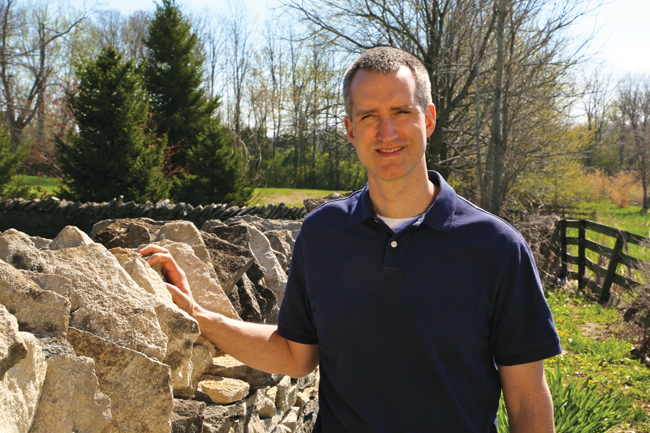BY NANCY R. HILLER
Bart Hammond was 20,000 feet in the air when the decidedly down-to-earth art of dry stone masonry first caught his attention. A U.S. Marine Corps officer in training during the mid-90s, Hammond was flying home to the Midwest from Quantico, Virginia, flipping through a magazine. A story about a Scottish dry stone wall building competition held him rapt for the remainder of the flight.
Hammond’s interest in the craft is easy to understand. Incorporating age-old construction principles, the walls exude an earthy elegance. Built from local stone, they vary in design from one region to another. Since their structural integrity depends on friction and gravity, not mortar, they work with nature instead of against it, which makes them unusually capable of withstanding harsh weather. Locally, the walls hug the twisting hills of Monroe County, where they were first built as cattle fencing by itinerant Irish masons in the late 19th century.
In the early 2000s, Hammond discovered the Dry Stone Conservancy, a nonprofit organization dedicated to preserving historic dry stone structures and advancing the craft of dry stone masonry. He took a three-day introductory course near Lexington, Kentucky, and was hooked. “I’ve always appreciated being able to see the fruits of my labor from start to finish,” he says. “Dry stone wall work has a puzzle element to it; the best work uses the stones, without modifying their existing shapes, to their best structural advantage.” He dreamed of working professionally in the field someday.
His chance came in 2013. By then he had followed a circuitous route that took him from the Marine Corps to Indianapolis, where he met his wife, Jennifer, then to Vermont, and finally to Bloomington, which he and Jennifer consider “the gem of Indiana.” For a few years he did administrative work for the Federal Aviation Administration at Indianapolis International Airport, but he hated being stuck at a desk. Finally, with his wife’s encouragement, he wrote a business plan for a dry stone masonry enterprise, Blue Valley Farm.
Hammond, now 40, has completed further training and earned Level One certification from the Dry Stone Conservancy. In addition to constructing new walls, he repairs and restores old ones, many of which have been damaged by vibration from traffic, smashed in collisions, or partially dismantled by utility companies running cables and lines. Property owners sometimes attempt to repair the walls themselves, but the craft is far more subtle and labor-intensive than most imagine.
